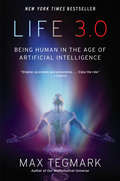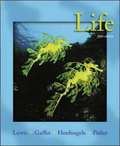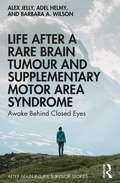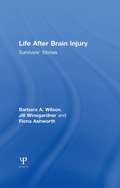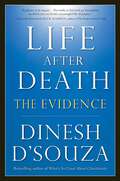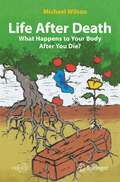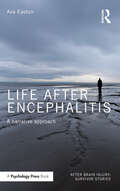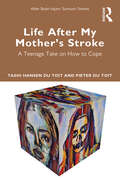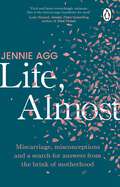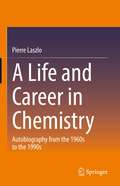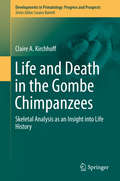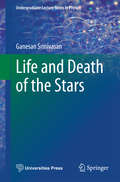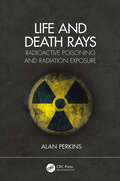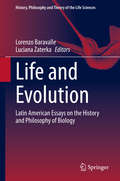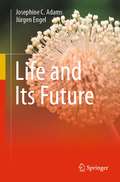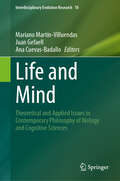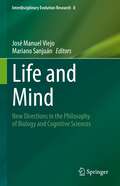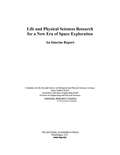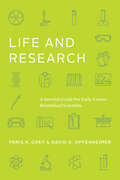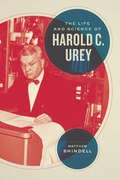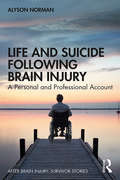- Table View
- List View
Life 3.0: Being Human in the Age of Artificial Intelligence
by Max TegmarkNew York Times Best SellerHow will Artificial Intelligence affect crime, war, justice, jobs, society and our very sense of being human? The rise of AI has the potential to transform our future more than any other technology—and there&’s nobody better qualified or situated to explore that future than Max Tegmark, an MIT professor who&’s helped mainstream research on how to keep AI beneficial. How can we grow our prosperity through automation without leaving people lacking income or purpose? What career advice should we give today&’s kids? How can we make future AI systems more robust, so that they do what we want without crashing, malfunctioning or getting hacked? Should we fear an arms race in lethal autonomous weapons? Will machines eventually outsmart us at all tasks, replacing humans on the job market and perhaps altogether? Will AI help life flourish like never before or give us more power than we can handle? What sort of future do you want? This book empowers you to join what may be the most important conversation of our time. It doesn&’t shy away from the full range of viewpoints or from the most controversial issues—from superintelligence to meaning, consciousness and the ultimate physical limits on life in the cosmos.
Life, 5th edition
by Bruce Parker Marielle Hoefnagels Douglas Gaffin Ricki LewisIntroduction to Biology textbook.
Life After a Rare Brain Tumour and Supplementary Motor Area Syndrome: Awake Behind Closed Eyes (After Brain Injury: Survivor Stories)
by Alex Jelly Adel Helmy Barbara A. WilsonThis book offers a personal insight into the experience of Alex Jelly, a professional fundraiser who developed a rare brain tumour, a papillary meningioma, which was successfully removed. She was left with Supplementary Motor Area Syndrome and associated problems including motor and speech impairments and a temporary psychosis. Discussing Alex’s struggles and triumphs throughout her rehabilitation, this book offers an honest account of her journey from diagnosis to recovery. Part I introduces Alex’s early life and employment, symptom onset and diagnosis, treatment and rehabilitation. Part II presents her neurosurgeon, Adel Helmy, and a clinical neuropsychologist, Barbara A. Wilson. Adel provides a medical context by explaining Alex’s successful surgery and her post-operative experience. Finally, Barbara concludes with a comprehensive view of Alex’s recovery and gives a voice to the therapists and psychologists who worked with Alex throughout her in and outpatient rehabilitation journey. This book provides support, understanding and hope for patients who have suffered a brain tumour, and their families. It is valuable reading for any professional involved in neurorehabilitation, studemts of clinical neuropsychology and those touched by brain injury.
Life After Brain Injury: Survivors' Stories (After Brain Injury: Survivor Stories)
by Barbara A. Wilson Jill Winegardner Fiona AshworthThis is the first book of its kind to include the personal accounts of people who have survived injury to the brain, along with professional therapists' reports of their progress through rehabilitation. The paintings and stories of survivors combine with experts' discussions of the theory and practice of brain injury rehabilitation to illustrate the ups and downs that survivors encounter in their journey from pre-injury status to insult and post-injury rehabilitation. Wilson, Winegardner and Ashworth's focus on the survivors' perspective shows how rehabilitation is an interactive process between people with brain injury, health care staff, and others, and gives the survivors the chance to tell their own stories of life before their injury, the nature of the insult, their early treatment, and subsequent rehabilitation. Presenting practical approaches to help survivors of brain injury achieve functionally relevant and meaningful goals, Life After Brain Injury: Survivors’ Stories will help all those working in rehabilitation understand the principles involved in holistic brain injury rehabilitation and how these principles, combined with theory and models, translate into clinical practice. This book will be of great interest to anyone who wishes to extend their knowledge of the latest theories and practices involved in making life more manageable for people who have suffered damage to the brain. Life After Brain Injury: Survivors’ Stories will also be essential for clinical psychologists, neuropsychologists, and anybody dealing with acquired brain injury whether they be a survivor of a brain injury themselves, a relative, a friend or a carer.
Life After Death: The Evidence
by Rick Warren Dinesh D'SouzaUnlike many books about the afterlife, Life after Death makes no appeal to religious faith, divine revelation, or sacred texts. Drawing on some of the most powerful theories and trends in physics, evolutionary biology, science, philosophy, and psychology, D'Souza shows why the atheist critique of immortality is irrational and draws the striking conclusion that it is reasonable to believe in life after death. He concludes by showing how life after death can give depth and significance to this life, a path to happiness, and reason for hope.
Life After Death: What Happens to Your Body After You Die? (Springer Praxis Books)
by Michael WilsonDeath is not an end – it’s a new beginning. After death, all of the molecules that came together to form the living “you” become nutrients for millions of creatures, large and small. Your body becomes the hub of a complex ecosystem of microbes, insects, worms, plants and more. Cheer up! This book shows how you are going to live forever – as components of so many other wonderful creatures. It describes the science behind the remarkable recycling of your body. We begin with lessons about how your body functions, is a collection of valuable nutrients and is a home to millions of microbes. The book goes on to describe the various stages the body passes through as it decomposes following death. The microbes and insects that make use of your tissues are then introduced. Finally, you will learn about the enduring effects that your body will have on the wider biosphere. We are rich in valuable resources that will end up feeding an immense number and variety of other creatures. Inevitably, your body will support the continuation of life on our beautiful planet – this book describes how all this happens.
Life After Encephalitis: A Narrative Approach (After Brain Injury: Survivor Stories)
by Ava EastonEncephalitis is a devastating condition whose impact upon people should not be underestimated. It robs people of abilities most of us take for granted, it leaves people without their loved ones, and even in those families where the person affected survives the person they once knew can be dramatically changed. Life After Encephalitis provides a unique insight into the experiences of those affected by encephalitis, sharing the rich, perceptive, and often powerful, narratives of survivors and family members. It shows how listening to patient and family narratives can help us to understand how they make sense of what has happened to them, and also help professionals better understand and engage with them in practice. The book will also be useful for considering narratives associated with brain injuries from other causes, for example traumatic brain injury. Life After Encephalitis will appeal to a wide range of professionals working in rehabilitation settings, and also to and survivors of encephalitis, their families, and carers.
Life After My Mother’s Stroke: A Teenage Take on How to Cope (After Brain Injury: Survivor Stories)
by Tashi Hansen du Toit Pieter du ToitTashi Hansen du Toit was 15 years old when her mother, Karen, suffered a severe haemorrhagic stroke which left her with multiple physical and cognitive impairments. This beautifully written and poignant account tells Tashi’s story from the first moments after her mother’s stroke, following her and her family through the experience of her mother’s hospitalisation and rehabilitation. Tashi offers a rare glimpse into the impact of her mother’s stroke on her family and on her life as a teenager as she juggles the stresses and demands of family, school, and friends alongside coping with her mother’s brain injury. As she describes how she is learning to cope with her unresolved grief three years on, she provides hope, perspective, and insight on how to work towards growth and acceptance despite the catastrophe of a parent’s stroke. Presenting the rarely heard adolescent perspective on parental brain injury, Tashi’s moving story also features Karen’s account as she comes to terms with her experience. This authentic book offers great support to others, particularly teenagers, who may be going through a similar experience. It is also valuable reading for those working in brain injury services and the education system, and for any professional or student involved in neurorehabilitation or supporting families of parents with brain injury.
Life After Whale: The Amazing Ecosystem of a Whale Fall
by Lynn BrunelleFollow a blue whale&’s enormous body to the bottom of the ocean, where it sets the stage for a bustling new ecosystem to flourish.All living things must one day die, and Earth&’s largest creature, the majestic blue whale, is no exception. But in nature, death is never a true ending. When this whale closes her eyes for the last time in her 90-year life, a process known as whale fall is just beginning. Her body will float to the surface, then slowly sink through the deep; from inflated behemoth to clean-picked skeleton, it will offer food and shelter at each stage to a vast diversity of organisms, over the course of a century and beyond. Caldecott Medalist Jason Chin&’s astonishing artwork enriches and amplifies engaging, well-researched text by Bill Nye the Science Guy writer Lynn Brunelle. Young lovers of the macabre will relish each page of Life After Whale. Meanwhile, those grappling with the hard subject of death will take solace in this honest look at the circle of life, which closes on a young whale enjoying the same waves as her ancestor. Additional back pages offer further info and reading recommendations on whales, whale falls, and ecosystems.A Junior Library Guild Gold Standard Selection
Life, Almost: Miscarriage, misconceptions and a search for answers from the brink of motherhood
by Jennie Agg'Vital and heart-wrenchingly intimate' Leah Hazard'Urgent, fascinating and thought-provoking' Julia Bueno'Thoughtfully researched and beautifully written' Pippa VosperAfter losing four pregnancies with no obvious cause, Jennie Agg set out to understand why miscarriage remains such a profoundly misunderstood, under-researched and under-acknowledged experience.Part-memoir, part-scientific investigation, Life, Almost documents Agg's path to motherhood and her search for answers. Tracing each tentative step of her fifth pregnancy - as her body becomes a creature she does not wish to spook - Agg dismantles the myths that we unquestioningly accept about our reproductive lives:· Why are we told miscarriage can't be prevented when half of all miscarriages are of perfectly healthy embryos?· Why is it normal not to tell anyone you're pregnant for the first three months? · Why don't we know why labour starts? Drawing on pioneering research and interviews with world-leading experts, Life, Almost is a ground-breaking book that will change how you think about miscarriage, and a moving reflection on grief and love at the edge of life as we understand it.
A Life and Career in Chemistry: Autobiography from the 1960s to the 1990s
by Pierre LaszloThis book is an enthusiastic account of Pierre Laszlo’s life and pioneering work on catalysis of organic reactions by modified clays, and his reflections on doing science from the 1960s to 1990s. In this autobiography, readers will discover a first-hand testimony of the chemical revolution in the second half of the 20th century, and the author’s perspective on finding a calling in science and chemistry, as well as his own experience on doing science, teaching science and managing a scientific career.During this period, Pierre Laszlo led an academic laboratory and worked also in three different countries: the US, Belgium and France, where he had the opportunity to meet remarkable colleagues. In this book, he recalls his encounters and collaborations with important scientists, who shaped the nature of chemistry at times of increased pace of change, and collates a portrait of the worldwide scientific community at that time. In addition, the author tells us about the turns and twists of his own life, and how he ended up focusing his research on clay based chemistry, where clay minerals were turned in his lab to catalysis of key chemical transformations. Given its breath, the book offers a genuine information on the life and career of a chemist, and it will appeal not only to scientists and students, but also to historians of science and to the general reader.
Life and Death in the Gombe Chimpanzees: Skeletal Analysis as an Insight into Life History (Developments in Primatology: Progress and Prospects)
by Claire A. KirchhoffThis book addresses how skeletons can inform us about behavior by describing skeletal lesions in the Gombe chimpanzees, relating them to known life histories whenever possible, and analyzing demographic patterns in the sample. This is of particular interest to both primatologists and skeletal analysts who have benefited from published data on a smaller, earlier skeletal sample from Gombe. The Gombe skeletal collection is the largest collection of wild chimpanzees with known life histories in existence, and this work significantly expands the skeletal sample from this long-term research site (49 chimpanzees). The book explores topics of general interest to skeletal analysts such as demographic patterns, which injuries leave signs on the skeleton, and rates of healing, and discusses both qualitative and quantitative analysis of the patterning of lesions. The book presents the data in a narrative style similar to that employed in Dr. Goodall’s seminal work The Chimpanzees of Gombe. Readers already familiar with the Gombe chimpanzees are likely to appreciate summaries of life events correlated to observable skeletal features. The book is especially relevant at this time to remind primate conservationists of the importance of the isolated chimpanzee population at Gombe National Park as well as the availability of the skeletons for study, both within the park itself as well as at the University of Minnesota.
The Life and Death of Stars
by Kenneth R. LangIn this well-illustrated text, Kenneth R. Lang explains the life cycle of stars, from the dense molecular clouds that are stellar nurseries to the enigmatic nebulae some stars leave behind in their violent ends. Free of mathematical equations and technical jargon, Lang's lively and accessible text provides physical insights into how stars such as our Sun are born, what fuels them and keeps them bright, how they evolve, and the processes by which they eventually die. The book demonstrates the sheer scope and variety of stellar phenomena in the context of the universe as a whole. Boxed focus elements enhance and amplify the discussion for readers looking for more depth. Featuring more than 150 figures, including color plates, The Life and Death of Stars is a modern and up-to-date account of stars written for a broad audience, from armchair astronomers and popular science readers to students and teachers of science.
Life and Death of the Stars
by Ganesan SrinivasanThis volume is devoted to one of the fascinating things about stars: how they evolve as they age. This evolution is different for stars of different masses. How stars end their lives when their supply of energy is exhausted also depends on their masses. Interestingly, astronomers conjectured about the ultimate fate of the stars even before the details of their evolution became clear. Part I of this book gives an account of the remarkable predictions made during the 1920s and 1930s concerning the ultimate fate of stars. Since much of this development hinged on quantum physics that emerged during this time, a detailed introduction to the relevant physics is included in the book. Part II is a summary of the life history of stars. This discussion is divided into three parts: low-mass stars, like our Sun, intermediate-mass stars, and massive stars. Many of the concepts of contemporary astrophysics were built on the foundation erected by Subrahmanyan Chandrasekhar in the 1930s. This book, written during his birth centenary, includes a brief biographical sketch of the brilliant scientist, which readers will find fascinating. Reading this book will get young students excited about the presently unfolding revolution in astronomy and the challenges that await them in the world of physics, engineering and technology. General readers will also find the book appealing for its highly accessible narrative of the physics of stars. This book is a companion volume of "What are the Stars?" by the same author. "I know of no other book on the evolution of stars of a similar scope and breadth that is so accessible for undergraduate students. " E P J van den Heuvel Professor of Astrophysics Winner of the Spinoza and Descartes PrizesUniversity of Amsterdam, The Netherlands
Life and Death Rays: Radioactive Poisoning and Radiation Exposure
by Alan PerkinsThis unique book provides an accessible introduction to both the scientific background and the key people involved in the discovery and use of radiation and radioactivity. It begins by providing a short history of radiation exposures and radiation poisoning; from the early inappropriate use of X-rays and radium cures through the misadventures of the Manhattan Project and the Chernobyl disaster, to the high-profile and deliberate poisoning of Alexander Litvinenko in London with polonium-210, which gave rise to worldwide media attention. The chapters provide a catalogue of deliberate criminal acts, unfortunate accidents, and inadvertent radiation exposures, exploring well-known events in detail, as well as some not so well-known occurrences. It works through the topics by focusing on human stories and events and their biological impact. In addition, it covers descriptions of the beneficial uses of radiation and radioactivity. This book can be enjoyed by any reader with a general interest in science, as well as by students and professionals within the scientific and medical communities. Key features Authored by a subject area specialist who has worked in both clinical practice and academia and was involved with the national media following incidents of national and international importance Provides a unique human perspective into well-known and some lesser known events and a concise history of the discovery of radiation and the events that followed Adds scientific and medical background to a subject of high media interest
Life and Evolution: Latin American Essays on the History and Philosophy of Biology (History, Philosophy and Theory of the Life Sciences #26)
by Lorenzo Baravalle Luciana ZaterkaThis book offers to the international reader a collection of original articles of some of the most skillful historians and philosophers of biology currently working in Latin American universities. During the last decades, increasing attention has been paid in Latin America to the history and philosophy of biology, but since many local authors prefer to write in Spanish or in Portuguese, their ideas have barely crossed the boundaries of the continent. This volume aims to remedy this state of things, providing a good sample of this production to the English speaking readers, bringing together contributions from researchers working in Brazilian, Argentinean, Chilean, Colombian and Mexican universities. The stress on the regional provenance of the authors is not intended to suggest the existence of something like a Latin American history and philosophy of biology, supposedly endowed with distinctive features. On the contrary, the editors firmly believe that advances in this field can be achieved only by stimulating the integration in the international debate. Based on this assumption, the book focuses on two topics, life and evolution, and presents a selection of contributions addressing issues such as the history of the concept of life, the philosophical reflection on life manipulation and life extension, the structure and development of evolutionary theory as well as human evolution. Life and Evolution – Latin American Essays on the History and Philosophy of Biology will provide the international reader with a rather complete picture of the ongoing research in the history and philosophy of biology in Latin America, offering a snapshot of this dynamic community. It will also contribute to contextualize and develop the debate concerning life and evolution, and the relation between the two phenomena.
Life and Its Future
by Josephine C. Adams Jürgen EngelThis book is aimed at those who wish to understand more about the molecular basis of life and how life on earth may change in coming centuries. Readers of this book will gain knowledge of how life began on Earth, the natural processes that have led to the great diversity of biological organisms that exist today, recent research into the possibility of life on other planets, and how the future of life on earth faces unprecedented pressures from human-made activities. Readers will obtain a perspective on the potential risks of chemical or nuclear warfare, and the ever-increasing risks from human activities that are causing pollution and climate change with global heating. Readers will also learn about ongoing research efforts to generate “designer lifeforms” through synthetic biology and applications of artificial intelligence. The book makes an integrated, up-to-date, overview of topics often considered as separate fields. It should be valuable to students, teachers, and people who are concerned about the future of life.
Life and Mind: Theoretical and Applied Issues in Contemporary Philosophy of Biology and Cognitive Sciences (Interdisciplinary Evolution Research #10)
by Mariano Martín-Villuendas Juan Gefaell Ana Cuevas-BadalloIn recent times, the philosophy of science has been reinvigorated by insights from the biological and cognitive sciences. These disciplines have provided not only new perspectives to approach traditional philosophical problems but have also opened the way to new conceptual and methodological questions that call for new and innovative solutions. This book brings together some of the main debates that have structured in the last years the fields of philosophy of biology and cognitive sciences. It is organized around 11 chapters distributed in two parts: one devoted to the philosophy of biology, and the other to the cognitive sciences. These ideas were originally presented at the 11th edition of the International Philosophy of Biology and Cognitive Science (PBCS-XI) workshop held in 2022 in Salamanca, Spain. Part I of the volume is devoted to topics related to the philosophy of biology and includes hot topics such as “biological functions”, “modelization”, “pain medicine”, or “organicism”. Part II is devoted to debates in the cognitive sciences and includes issues related to "ecological psychology", "enactivism", "FEP" or "animal cognition". Considering the diversity of the topics covered in this volume, the book is purposely conceived to serve as an updated introduction to the fields of the philosophy of biology and cognitive sciences for those researchers interested in having a panoramic view of these two areas of inquiry. But not only that, the detailed and scholarly coverage of the topics included renders this book appealing to a much more specialized audience interested in particular aspects of each of the debates already mentioned.
Life and Mind: New Directions in the Philosophy of Biology and Cognitive Sciences (Interdisciplinary Evolution Research #8)
by José Manuel Viejo Mariano SanjuánThis volume provides a broad overview of some cutting-edge philosophical topics of growing interest at the juncture between cognitive science and biology. The main goal is not to integrate the variety of approaches into a single account, but rather to offer diverse perspectives on a collection of selected biological issues of particular philosophical relevance, reflecting the plurality of current research in these areas. Four conceptual vectors give this volume its coherence: Animal and human cognition: With respect to animal cognition, this volume focuses on self-awareness and methodological flaws in the science of animal consciousness. Regarding human cognition, the authors of this volume address various aspects of so-called 4E cognition. Genetics: The role of genes in the development of mind and life has always been philosophically controversial. In this volume, the authors address the possibility of considering post-genomic genes as natural kinds and the proper analysis of the concept of genotype. Teleology: This volume addresses issues of evolutionary causality and teleosemantics, as well as questions relating to biological teleology and regulation. Evolution: Evolution exemplifies better than any other concept the convergence point between philosophy, biology and cognitive sciences. Among other things, the volume deals with the origin of novelties in evolutionary processes from various viewpoints (e.g., cultural evolution and developmental plasticity). Despite their disparity, all these topics belong to a common naturalistic framework. By presenting them in a single volume, the editors want to emphasize the need to always conduct philosophical research on mind and life with tangential domains in mind.This book is a valuable resource for students and researchers of philosophy with a special interest in life, cognition, and evolution, as well as for biologists and cognitive scientists.
Life and Physical Sciences Research for a New Era of Space Exploration: An Interim Report
by National Research Council of the National AcademiesIn response to requests from Congress, NASA asked the National Research Council to undertake a decadal survey of life and physical sciences in microgravity. Developed in consultation with members of the life and physical sciences communities, the guiding principle for the study is to set an agenda for research for the next decade that will allow the use of the space environment to solve complex problems in life and physical sciences so as to deliver both new knowledge and practical benefits for humankind as we become a spacefaring people. The project's statement of task calls for delivery of two books--an interim report and a final survey report. Although the development of specific recommendations is deferred until the final book, this interim report does attempt to identify programmatic needs and issues to guide near-term decisions that are critical to strengthening the organization and management of life and physical sciences research at NASA.
Life and Research: A Survival Guide for Early-Career Biomedical Scientists (Chicago Guides to Academic Life)
by Paris H. Grey David G. OppenheimerLife in a research lab can be daunting, especially for early-career scientists. Personal and professional hurdles abound in bench research, and this book by two seasoned lab professionals is here to help graduate students, postdocs, and staff scientists recognize stumbling blocks and avoid common pitfalls. Building and maintaining a mentoring network, practicing self-care and having a life outside of the lab, understanding that what works perfectly for a labmate might not work for you—these are just a few of the strategies that lab manager and molecular biologist Paris H. Grey and PI and geneticist David G. Oppenheimer wished they had implemented far sooner in their careers. They also offer practical advice on managing research projects, sharing your work on social media, and attending conferences. Above all, they coach early-career scientists to avoid burnout and make the most of every lab experience to grow and learn.
Life and Research: A Survival Guide for Early-Career Biomedical Scientists (Chicago Guides to Academic Life)
by Paris H. Grey David G. OppenheimerLife in a research lab can be daunting, especially for early-career scientists. Personal and professional hurdles abound in bench research, and this book by two seasoned lab professionals is here to help graduate students, postdocs, and staff scientists recognize stumbling blocks and avoid common pitfalls. Building and maintaining a mentoring network, practicing self-care and having a life outside of the lab, understanding that what works perfectly for a labmate might not work for you—these are just a few of the strategies that lab manager and molecular biologist Paris H. Grey and PI and geneticist David G. Oppenheimer wished they had implemented far sooner in their careers. They also offer practical advice on managing research projects, sharing your work on social media, and attending conferences. Above all, they coach early-career scientists to avoid burnout and make the most of every lab experience to grow and learn.
Life and Research: A Survival Guide for Early-Career Biomedical Scientists (Chicago Guides to Academic Life)
by Paris H. Grey David G. OppenheimerLife in a research lab can be daunting, especially for early-career scientists. Personal and professional hurdles abound in bench research, and this book by two seasoned lab professionals is here to help graduate students, postdocs, and staff scientists recognize stumbling blocks and avoid common pitfalls. Building and maintaining a mentoring network, practicing self-care and having a life outside of the lab, understanding that what works perfectly for a labmate might not work for you—these are just a few of the strategies that lab manager and molecular biologist Paris H. Grey and PI and geneticist David G. Oppenheimer wished they had implemented far sooner in their careers. They also offer practical advice on managing research projects, sharing your work on social media, and attending conferences. Above all, they coach early-career scientists to avoid burnout and make the most of every lab experience to grow and learn.
The Life and Science of Harold C. Urey (Synthesis)
by Matthew ShindellHarold C. Urey (1893–1981), whose discoveries lie at the foundation of modern science, was one of the most famous American scientists of the twentieth century. Born in rural Indiana, his evolution from small-town farm boy to scientific celebrity made him a symbol and spokesman for American scientific authority. Because he rose to fame alongside the prestige of American science, the story of his life reflects broader changes in the social and intellectual landscape of twentieth-century America. In this, the first ever biography of the chemist, Matthew Shindell shines new light on Urey’s struggles and achievements in a thoughtful exploration of the science, politics, and society of the Cold War era. From Urey’s orthodox religious upbringing to his death in 1981, Shindell follows the scientist through nearly a century of American history: his discovery of deuterium and heavy water earned him the Nobel Prize in 1934, his work on the Manhattan Project helped usher in the atomic age, he initiated a generation of American scientists into the world of quantum physics and chemistry, and he took on the origin of the Moon in NASA’s lunar exploration program. Despite his success, however, Urey had difficulty navigating the nuclear age. In later years he lived in the shadow of the bomb he helped create, plagued by the uncertainties unleashed by the rise of American science and unable to reconcile the consequences of scientific progress with the morality of religion. Tracing Urey’s life through two world wars and the Cold War not only conveys the complex historical relationship between science and religion in the twentieth century, but it also illustrates how these complexities spilled over into the early days of space science. More than a life story, this book immerses readers in the trials and triumphs of an extraordinary man and his extraordinary times.
Life and Suicide Following Brain Injury: A Personal and Professional Account (After Brain Injury: Survivor Stories)
by Alyson NormanLife and Suicide Following Brain Injury tells the story of Tom, a 43 year-old man who acquired a brain injury from a road traffic accident at the age of 22. Tom survived but went on to take his own life 20 years later. As a vulnerable adult with mental health issues and long-term difficulties with substance misuse, this book tells Tom's story from his early childhood through to his death. In telling Tom's story, the author- a researcher in the brain injury field and Tom's sister- identifies the multiple suicide risk factors as well as the lack of understanding and inadequate service provision for people with complex needs following TBI. His story serves as a harrowing example of what can go wrong when timely intervention and support is not forthcoming, identifying a multitude of risk factors and possible points of intervention to improve care in the future. This book provides insight to professionals and academics across health and social care in the risks of suicide associated with TBI. It also provides support for those who have experienced the grief of losing a survivor to suicide, or those struggling to support a survivor who is suicidal.
